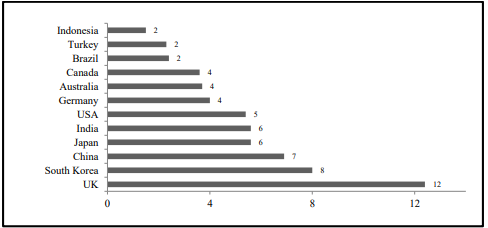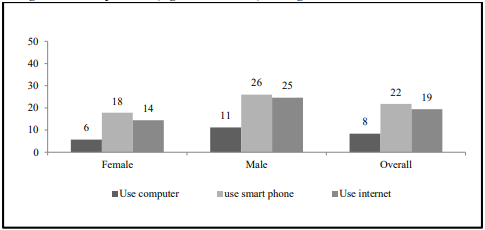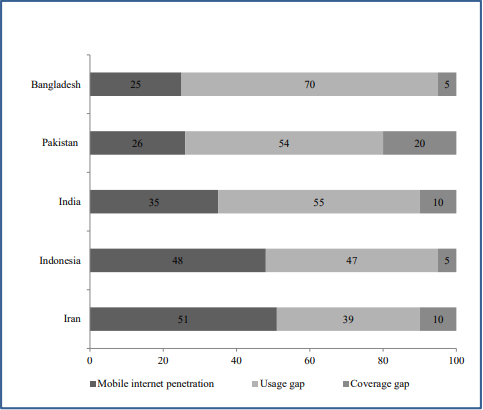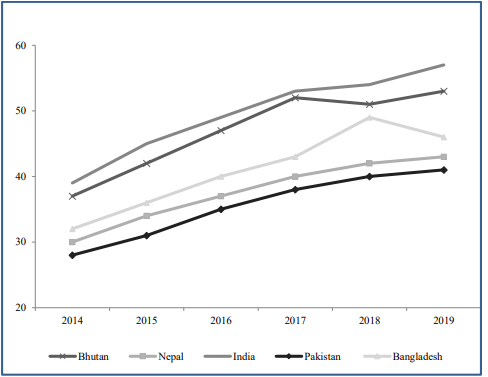
Pakistan Institute of Development Economics
- Home
Our Portals
MenuMenuMenuMenuMenuMenuMenu - ResearchMenuMenuMenuMenuMenuMenuMenu
- Discourse
- The PDR
- Our Researchers
- Academics
- Degree Verification
- Thesis Portal
- Our Portals
THE PAKISTAN DEVELOPMENT REVIEW
Internet’s Access in Pakistan: Issues and Way Forward
INTRODUCTION
Internet is the most revolutionary technology that impacts individuals, economy and culture of any society. It has been shaping a major paradigm shift in business strategies. Entrepreneur and businessmen are able to reduce both the production and transaction costs, foster spread of new ideas and enhance productivity, Manyika & Roxburgh (2010). The impacts are widespread on promoting market efficiency, Dolata (2018).
Fig. 1. Internet Economy as % of GDP

Source: Organisation for Economic Cooperation & Development (OECD).
The internet has significantly reduced the transaction cost – businessmen can execute transactions online and investors can explore opportunities over the web. a patients can access and share medical reports with the doctors , and researchers can access the relevant literature. Thanks to internet, the goods and services, markets and financial systems are only a click away from buyers, sellers and users. The COVID-19 pandemic has led to an inevitable surge in uses of internet—for online education, ecommerce and of course office-meetings etc. Pandey & Pal (2020); Rabul & Pal (2020).
The internet economy is defined as “the full range of economic, social and cultural activities supported by the internet and related information and communications technologies” (OECD 2008a).
There are three sorts of economic impacts of using internet; (i) direct value addition in GDP, (ii) consumer surplus and welfare gains in various sectors; and (iii) net GDP growth generated by all activities related to the internet. On average the share of internet in world’s GDP is around 3.4 percent with sizeable variations across countries (Figure 1), leaving large room for low income countries Hailu (2014). Over the past 15 years, the internet has accounted for 10 percent of world’s GDP growth. Evidence suggests that a 10 percent increase in per capita GDP is associated with a 21.5 percent increase in the number of internet users per capita Amiri & Reif (2013); Andres, et al. (2010). Of course it has threatened some jobs, but then it is also a powerful catalyst for job creation, spread of news ideas, innovation and competition.
A significant population of Pakistan has no access to internet. We believe that provision of internet to people residing in remote areas will improve their access to information, reduce various sorts of economic costs through the ‘death of distance’. Given this backdrop, Pakistan needs to have internet and digital tools available to almost all for improving human capital and economic growth.
A SNAPSHOT OF INTERNET ACCESS IN PAKISTAN
Access to information, communication and technology (ICT) tools facilitate the population, particularly youth by providing information about job opportunities, and entrepreneurship. The exposure to ICT tools is limited in Pakistan as only 8 percent of the population is using computer, 22 percent is using smart phone and 19 percent is using internet. The usage, is quite low among women as compared to men (Figure 2). As a result, Pakistan ranked at 133rd out of 134 countries on gender equality in internet in Network Readiness Index 2020.
Fig. 2. % of Population (Aged 15 & above) having Access to Various ICT Tools

Source: Estimated from HIES 2018/19.
Currently 25 percent of the youth is using internet and the rates considerably decline for elder population groups (19 percent for 30-49 years age group and 9 percent for 50 years and above). More than 60 percent of the population (aged 15 years and above) of the country are either illiterate or have a maximum education upto primary level; however, this large segment has very limited use of internet (only 6 percent). Education, urbanisation and remoteness (e.g. most of Balochistan) are the key drivers of internet usage.
Table 1
Purpose of Using the Internet among those Who Used It (% Distribution)
| Purpose | Male | Female | Both |
| Email, chat, facebook etc. | 78.2 | 49.9 | 67.1 |
| Calls and movies | 14.1 | 41.1 | 24.8 |
| Education and research | 3.4 | 6.0 | 4.4 |
| Information seeking (news, health etc.) | 1.9 | 1.8 | 1.9 |
| Business, shopping, banking | 2.0 | 1.1 | 1.7 |
| Downloading software & programmes | 0.3 | 0.1 | 0.2 |
| Total | 100 | 100 | 100 |
Source: Estimated from HIES 2018/19 micro dataset.
Business success is not possible without the internet as it allows digital marketing while examining customer data through analytics tools however, still 92 percent of the internet users in Pakistan are using it for non- business and not-so-creative activities, i.e. voice and video calls, and watching movies etc. (Table 1). There is a need to enhance internet access and e-commerce facility to various sectors of economy so that this may augment business and other productive activities.
Table 2
Reasons of Not Using Internet among Those Who Did Not Use It (% Distribution)
| Reasons | Male | Female | Both Sexes |
| Do not consider it useful | 56.3 | 49.2 | 52.4 |
| Do not know how to use it | 35.3 | 27.1 | 30.8 |
| Cost of using is high | 3.3 | 3.3 | 3.3 |
| Privacy or security concern | 0.2 | 0.5 | 0.3 |
| Lack of internet access | 1.0 | 0.5 | 0.8 |
| Cultural reasons, not allowed | 1.4 | 7.8 | 4.9 |
| Don’t know what is internet | 2.6 | 11.6 | 7.5 |
| Total | 100 | 100 | 100 |
Source: Estimated from HIES 2018/19 micro dataset.
For sustained economic growth, adoption of technology is imperative; therefore, awareness is essential on usage of internet and its potential benefits. Still, more than half of the population considers that internet is not useful, 31 percent do not know how to use it and 8 percent even do not know what the internet is (Table 2). To overcome these challenges, the country requires a digital inclusion strategy. This would involve targeting various socio-economic groups to overcome rural-urban divide, gender disparity and non-productive usage. The 2017-18 Pakistan Demographic and Health Survey shows that a very small proportion of men and women use mobile phone for financial transactions (21 percent and 7 percent, respectively).
Cellular Penetration: A Regional Comparison
The Mobile ecosystem in Pakistan contributes $16.7 billion to the economy (5.4 percent of GDP). The cellular sector created more than half a million direct and indirect jobs and this contributed $3.3 billion to public sector revenues in 2019/20. Mobile phone is the main tool used to access internet in Pakistan. Currently there are 180 million cellular subscribers which cover 84 percent population of the country. 46 percent are broadband subscribers; however most of them are using internet facilities through mobile phone (44.5 percent) rather than optic fibre (used by only 1 percent of subscribers) (Figure 3). Pakistan is an emerging cellular economy, but still only a limited population of Pakistan enjoys internet access.
Fig. 3. Cellular Subscribers in Pakistan

| 180 Million Cellular | 95 Million 3G/4G | 2 Million basic Telephony | 98 Million Broadband |
Source: Pakistan Telecommunication Authority (till February 2021).
Despite such a massive economic contribution, still more than half of the population does not own a mobile phone. The country witnessed an accelerated start of mobile subscribers in 2005; however, overtime it had not kept pace with diffusion of technology relative to other South Asian countries. The mobile penetration significantly dropped in 2015 when government implemented biometric SIM registration.
Fig. 4. Mobile Internet Penetration, Usage Gap & Coverage Gap

Source: GSMA 2020 Report.
Both the Bangladesh and Pakistan have lowest mobile internet penetration, thus leaving a sizeable usage gap—the population having mobile phones but not using internet is 54 percent in Pakistan and 70 percent in Bangladesh. The country requires a large effort to enhance mobile broadband coverage as still 20 percent of the population is outside the area covered by mobile phone operators (Figure 4).
The question arises ‘why there is a low mobile internet penetration in the country’. The answer is:
- (1) consumers face a variety of taxes and fees; the tax rate is 31 percent as a percentage of total cost of mobile ownership (TCMO)—significantly above the global average of 19 percent.
- (2) average capital expenditure as a proportion of revenue is lowest (23 percent) in South Asia, thus mobile operators do not enjoy enough financial capacity to spend on good quality services.
- (3) local manufacturing of IT goods is negligible. For example, the local handsets are hardly 10 percent of the total sets in use (Samsung and Huawei account for over half of all mobile phone sales).
- (4) 4G service is not available in most parts of the country.
Fig. 5. Mobile Connectivity Index

All the above have contributed to Pakistan being ranked lowest in the region on mobile connectivity index from 2014 to 2019 (Figure 5). (The index comprises four key enablers (infrastructure, affordability, consumer readiness and content services), 10 dimensions and 26 indicators.
The Issues of Spectrum availability in Pakistan
Spectrum is the radio frequency and right of use to mobile operators issued by the government. Pakistan has rigid spectrum availability as license award is not subject to the market demand, rather it depends on the government’s decision’ when to auction, the spectrum. The previous auctions of spectrum led to fragmentation in market as the bigger cellular companies purchased creating sort of monopoly. During 2014 to 2017, the government earned $1.8 billion by auctioning spectrum. Another $1 billion of spectrum sale is in process. The auctioning approach has a revenue focus rather than increasing internet access.
Resultantly the auctioning approach is:
- Is discoursing investment in internet infrastructure.
- Often the bureaucratic decisions led to delay of 2-3 years in auction.
- There is shortage of spectrum as well as its underutilisation because the release of frequency is linked to government’s revenue estimates rather than operators’ demand.
- Long term ((10-20 years) spectrum roadmap to promote competition is lacking.
- Multi-environment strategy regarding spectrum to reduce cost and improve technology is absent.
Way Forward to Promote Digital Economy
We are facing a tough situation where economic growth is not sufficient to generate enough jobs. Without provision of technological skills to the labour force, the issues of unemployment and underemployment will increase day-by-day – Internet access is a pre-requisite for proviso of technological skills. The following is suggested to promote digital economy in the country.
- (1) Our IT policy must focus on following five areas:
- (i) Access & connectivity: consider access to internet as a fundamental right of every citizen.
- (ii) Go Digital e., e-government, e-business, paper-less and cash-less economy.
- (iii) Also promote e-agriculture, e-education, e-health, e-commerce, e-justice etc.
- (iv) Digital skilling & training: impart digital skills to youth.
- (v) Innovation & entrepreneurship: promote digital technology in businesses so that our entrepreneurs can compete in the digitised business environment.
- (2) The government must rationalise taxes with long-term focus—considering access to internet as a necessity rather than a luxury. Taxes on imports, sales and registration of internet related devices may be reduced.
- (3) A 10-20 year spectrum strategy is required to promote healthy competition and cost-efficient technology. Spectrum should be available whenever market requires it. A significant part of the license fee must be linked with high-quality internet services in the remote areas so that operator can invest in infrastructure. The government must ease the laws for infrastructure sharing.
- (4) Providing internet access through fibre optic is much cheaper and faster than the cellular network. To make available cheaper internet and cellular services, the fibre optic must be extended to every city/town of the country. This will ultimately impact the digital ecosystem, transaction cost and economic growth. The country has to enhance local manufacturing capacity of cell phones and related devices. For this country would have to invest enough significantly on research & development.
- (5) Last but not least, the regulator must be efficient enough to embrace technology as a state policy by promoting a healthy competition in the market and by ensuring the rights of various stakeholders. The IT policy must have clear benchmarks, covering the following aspects:
- Foster competition in internet ecosystem to promote productivity.
- Promote online settlement of transactions.
- Both the education and IT policies must promote digital human capital.
- Build a cheap, efficient infrastructure to promote a digital society.
REFERENCES
Amiri, S. & Reif, B. (2013). Internet penetration and its correlation to gross domestic product: An analysis of the nordic countries. International Journal of Business, Humanities and Technology, 3(2), 50–60.
Andrés, L., et al. (2010). The diffusion of the Internet: A cross-country analysis. Telecommunications Policy, 34(5-6), 323–340.
Dolata, U. (2018). Internet companies: Market concentration, competition and power. In Collectivity and Power on the Internet. Springer. p. 85–108.
Hailu, H. (2014). The great transformer: The impact of internet on economic growth and prosperity.
Manyika, J. & Roxburgh, C. (2011). The great transformer: The impact of the Internet on economic growth and prosperity. McKinsey Global Institute. p. 0360–8581.
Pandey, N. & Pal, A. (2020). Impact of digital surge during Covid-19 pandemic: A viewpoint on research and practice. International Journal of Information Management, 55, 102–171.
Rahul De, N. P. & Pal, A. (2020). Impact of digital surge during Covid-19 pandemic: A viewpoint on research and practice. International Journal of Information Management, 55, 102–171.
Shujaat Farooq


